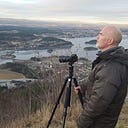The Medium Format Experience — High Iso and the Milky Way
I have for several years believed that shooting with a medium format camera at high iso would yield terrible results. Likely no point in trying because the image will be ruined because of noise, I have thought. However, this fall I nevertheless brought with me the Pentax 645Z and the Pentax 25mm f4 out into the darkness where the zombies reign — in my imagination anyway.
I would have loved to have an ultra wide angle f2.8 lens to the 645Z. That would assuredly have been an advantage. On the other hand, many claims that a larger sensor with larger pixels will capture more light, so perhaps a f/4 lens could work after all.
How did the 645Z fare? And did I survive the relentless attacks from the zombies? Let’s find out.
The following image is shot at iso 6400, and this is the straight out of camera version.
This is how the image looks after it is edited in Lightroom:
When I tried to open up the shadows further the foreground in particular turned magenta something which is easier to see in Lightroom than on a webpage. I must admit I was a tad disappointed when I saw this color shift in the deepest shadows. It isn’t difficult to rectify (for instance, paint over with the opposite color), but it is always more convenient to not have to.
In all honesty, I have witnessed deep shadows turn magenta with the Canon 6D which is considered a very decent high iso camera, and even the Pentax K-1 when pushed hard at high iso. For some reason I believed a medium format camera would behave differently.
Fortunately, I had my darkness paranoia reasonably under control this evening so that it became possible to shoot a 125 sec exposure for the shadows. Otherwise, the same settings as the sky exposure.
Straight out of camera:
Adjusted in Lightroom with plenty of shadow detail:
The sky and shadow exposures are blended in Photoshop and edited to my taste which not necessarily is your cup of tea or perhaps coffee (if that is your cup of tea):
I also wanted to test out what would happen if I shot iso 12800. Well, this happened:
When I began to push the file in Lightroom I got some weird color shifts in the foreground. It is not unlikely that my headlamp is partly responsible for this. I didn’t turn it off while the exposure ran due to some very fierce zombie attacks around that time. Even with my back to the camera some light has unfortunately leaked into the foreground.
In order to fix the foreground opted to create a virtual copy of the image which I desaturated. After I blended the two images (the original file and the virtual copy) in Photoshop, I added a slight blue tint to the foreground. Below is the finished image. I honestly had no idea when I started out editing that such a result would be possible at iso 12800. I have of course added some noise reduction here and there but considering the high iso the file was surprisingly “clean” from the outset.
To shoot at high iso with a medium format camera turned out to yield surprisingly good results. That I was “forced” to use a narrower aperture than what I usually prefer among other things produced rounder stars, more detail and a wider depth of field.
End note: I barely survived the zombie attacks, but I have hired bodyguards for the next time I head out to shoot the night sky. The pay is extremely low, but it is an exciting, meaningful (for me) and suspenseful job.
Please note that by adding a Dark Reader extension to your browser it is possible to view the images on a dark background.
